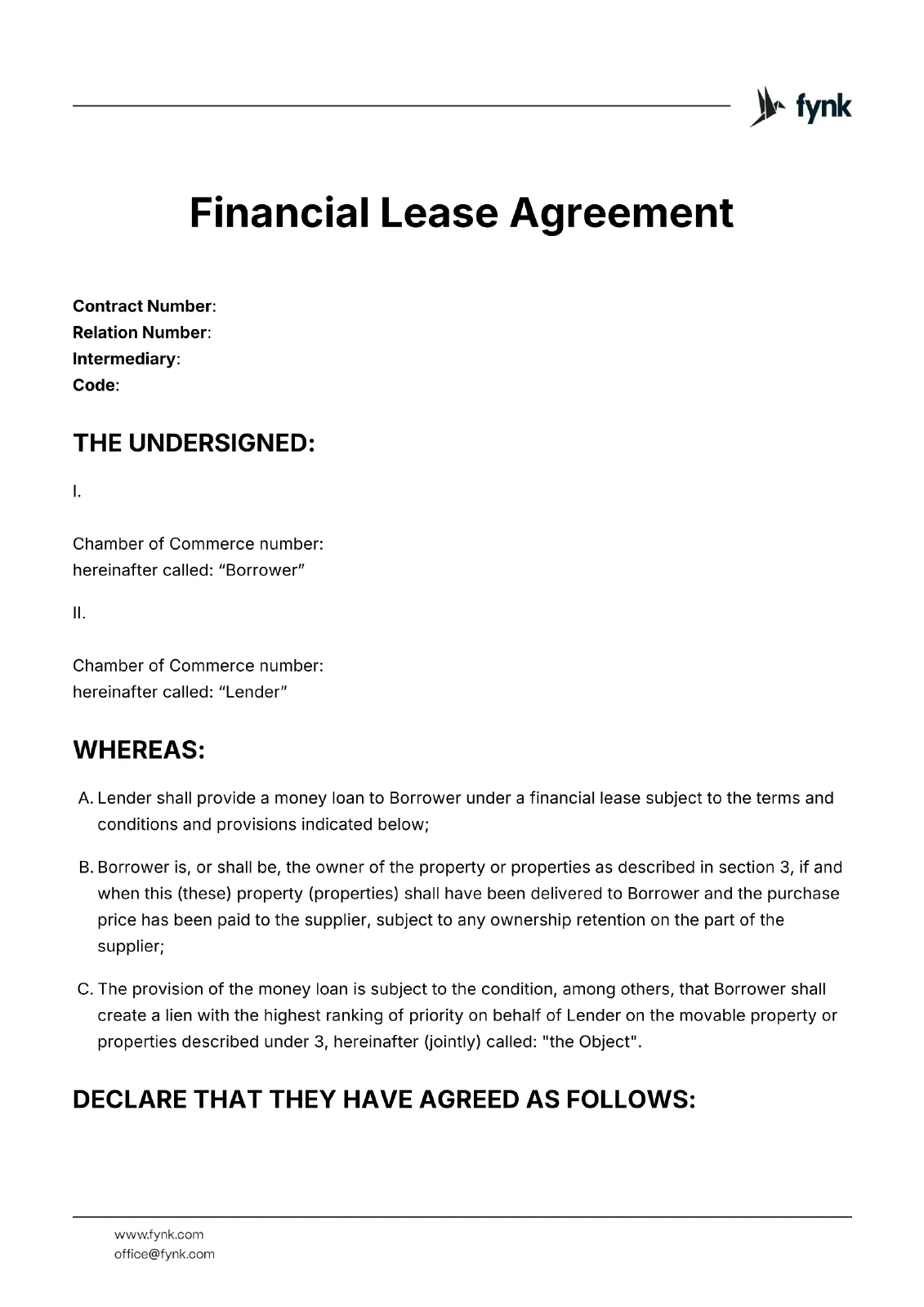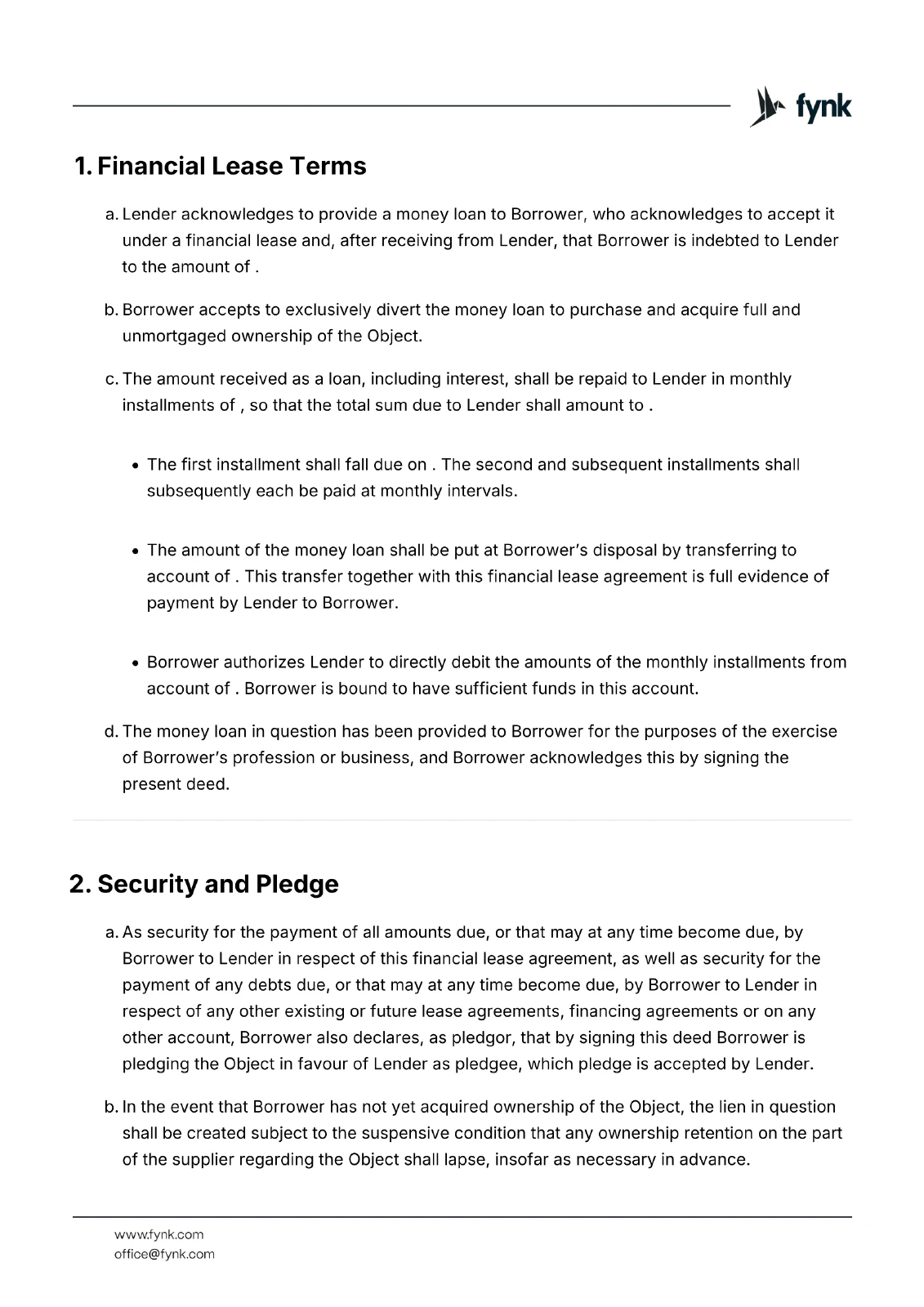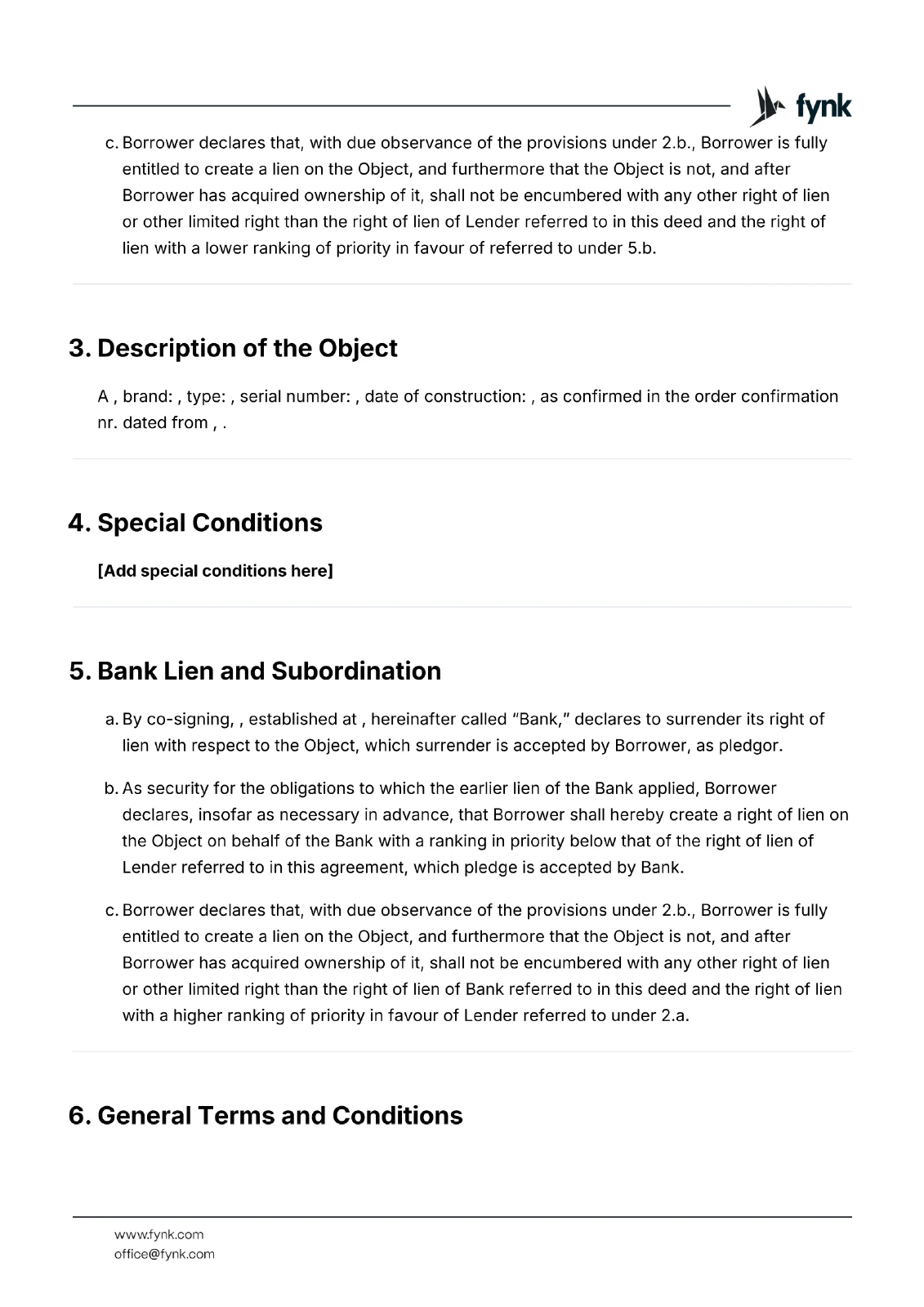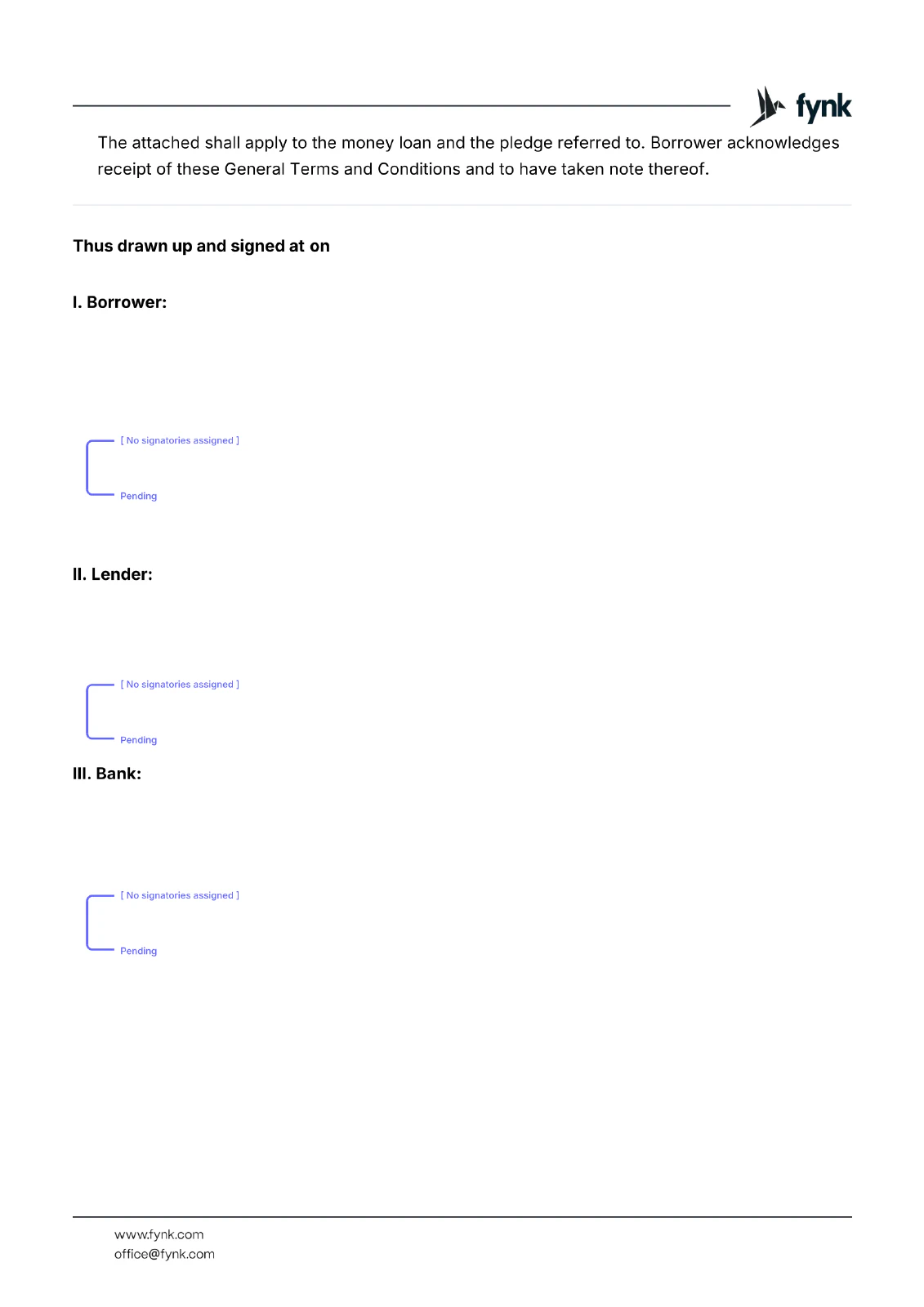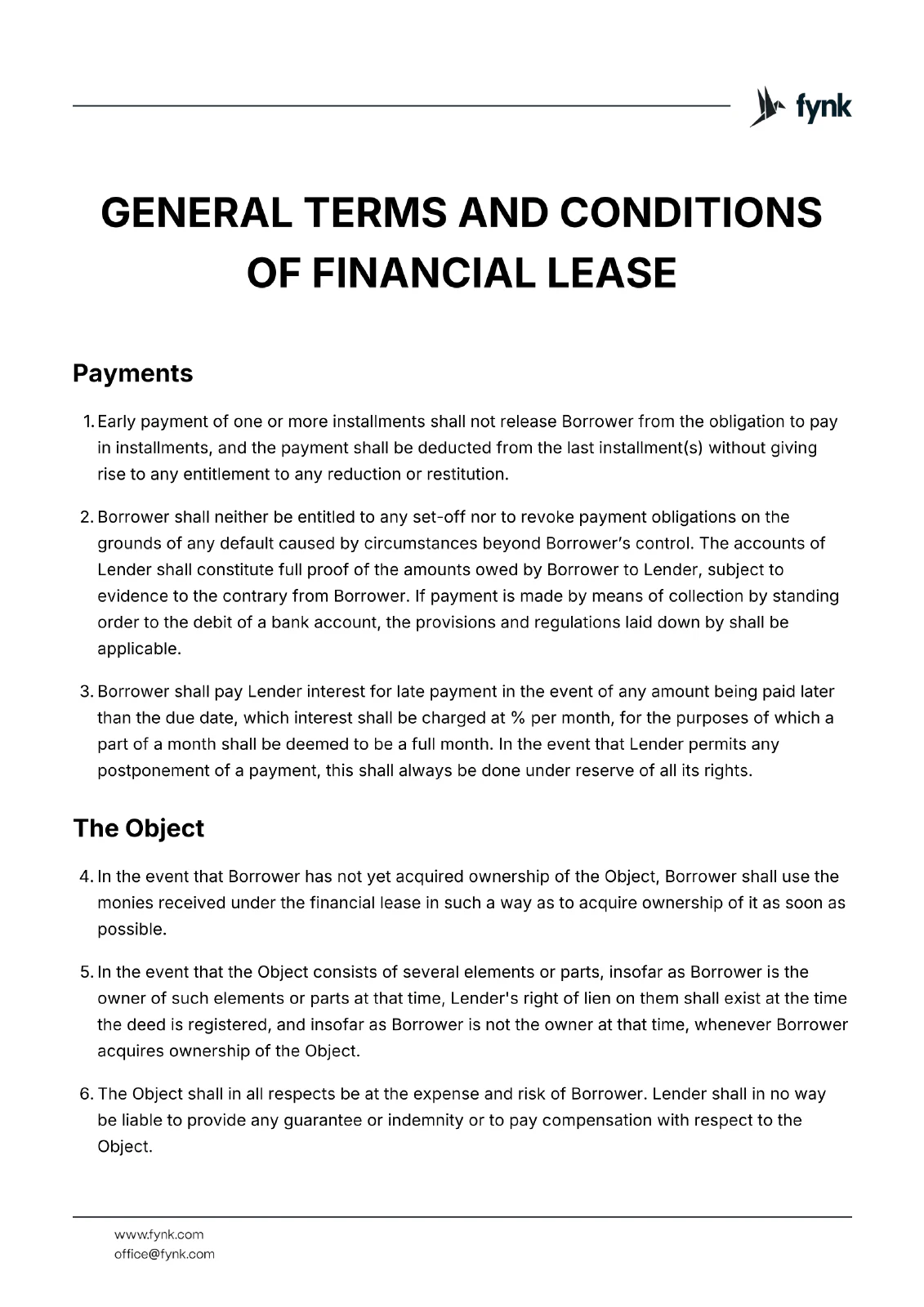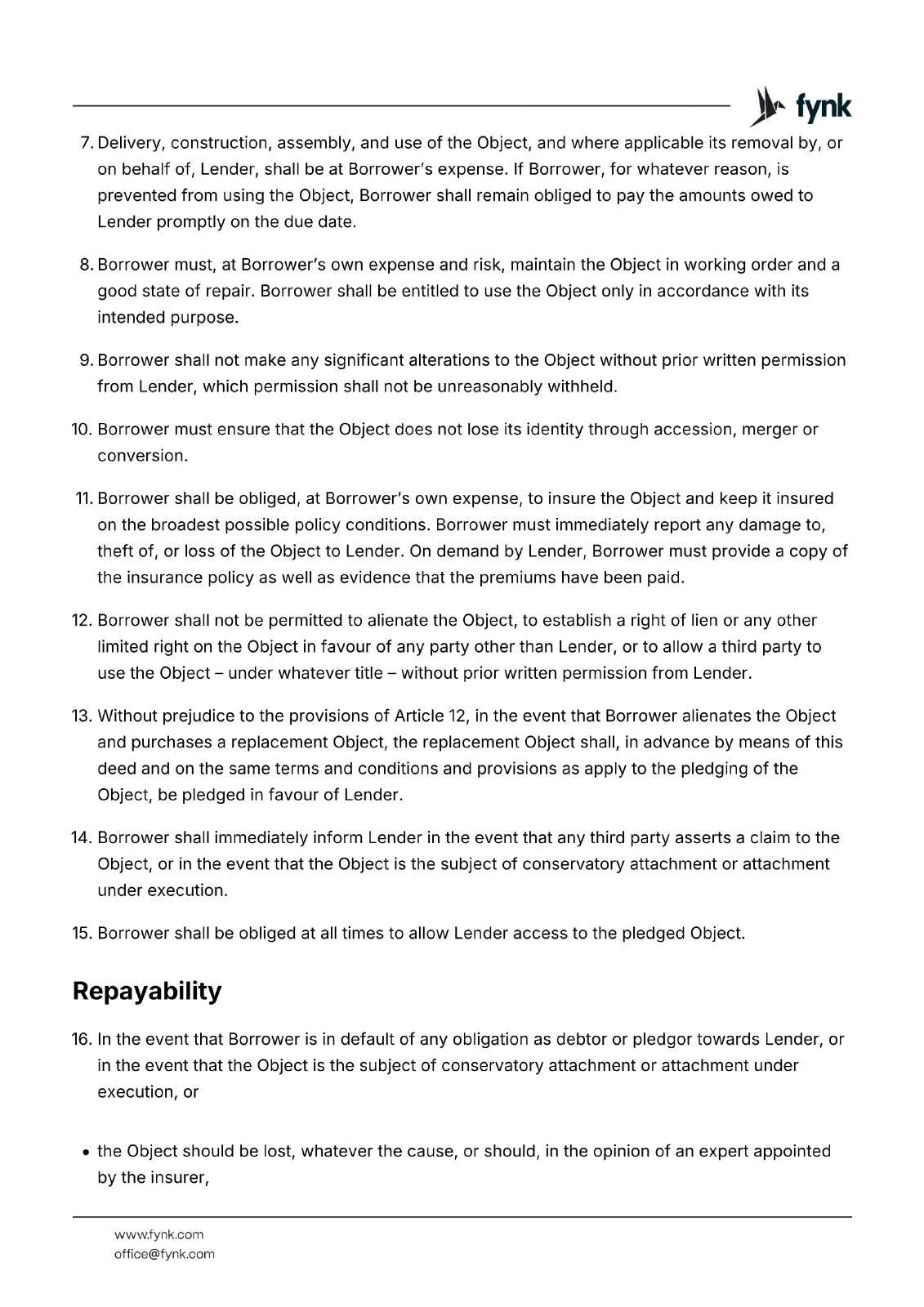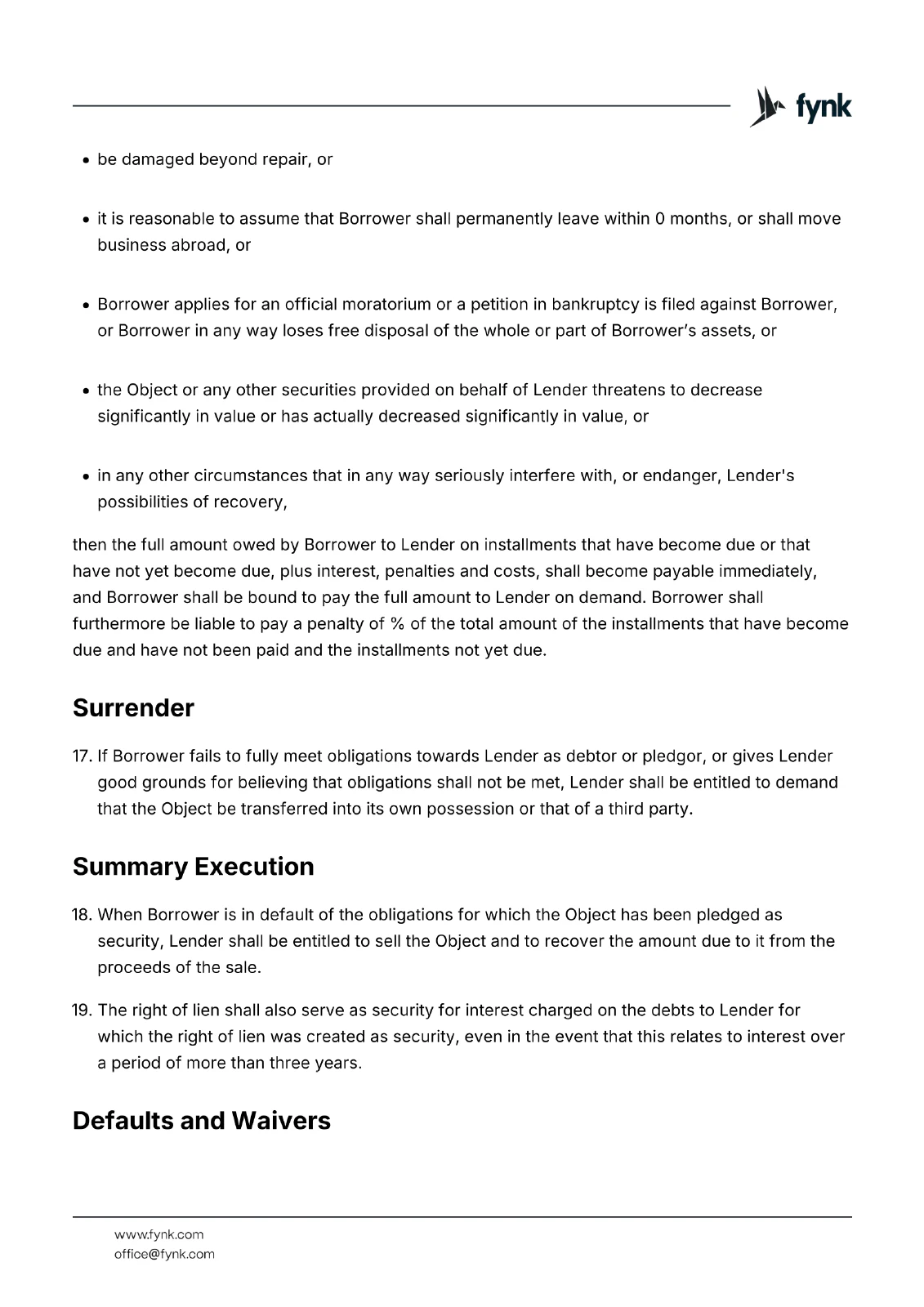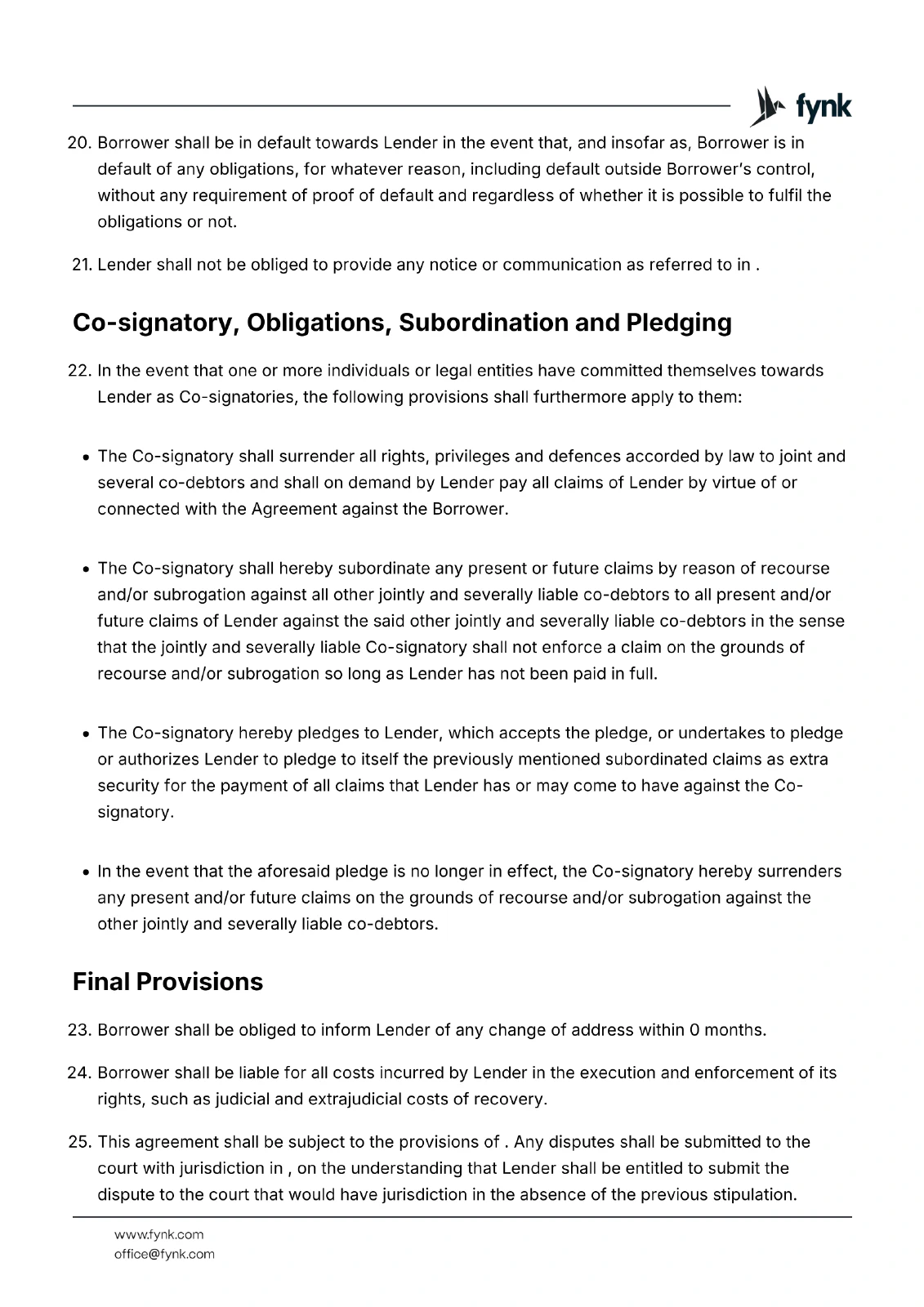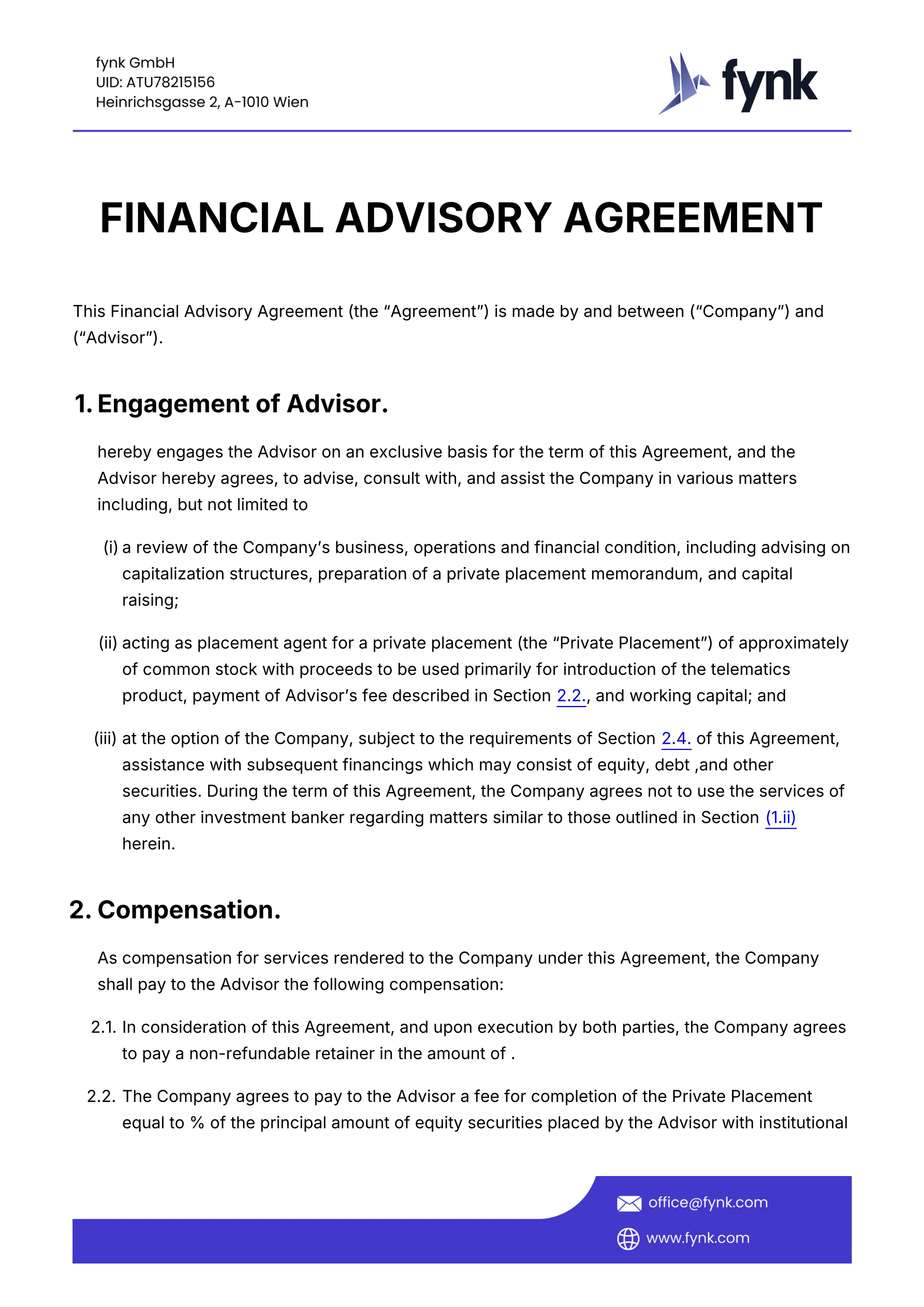Financial Lease Agreement
Contract Number:
Relation Number:
Intermediary:
Code:
THE UNDERSIGNED:
I.
Chamber of Commerce number:
hereinafter called: “Borrower”
II.
Chamber of Commerce number:
hereinafter called: “Lender”
WHEREAS:
Lender shall provide a money loan to Borrower under a financial lease subject to the terms and conditions and provisions indicated below;
Borrower is, or shall be, the owner of the property or properties as described in section 3, if and when this (these) property (properties) shall have been delivered to Borrower and the purchase price has been paid to the supplier, subject to any ownership retention on the part of the supplier;
The provision of the money loan is subject to the condition, among others, that Borrower shall create a lien with the highest ranking of priority on behalf of Lender on the movable property or properties described under 3, hereinafter (jointly) called: "the Object".
DECLARE THAT THEY HAVE AGREED AS FOLLOWS:
Financial Lease Terms
Lender acknowledges to provide a money loan to Borrower, who acknowledges to accept it under a financial lease and, after receiving from Lender, that Borrower is indebted to Lender to the amount of .
Borrower accepts to exclusively divert the money loan to purchase and acquire full and unmortgaged ownership of the Object.
The amount received as a loan, including interest, shall be repaid to Lender in monthly installments of , so that the total sum due to Lender shall amount to .
The first installment shall fall due on . The second and subsequent installments shall subsequently each be paid at monthly intervals.
The amount of the money loan shall be put at Borrower’s disposal by transferring to account of . This transfer together with this financial lease agreement is full evidence of payment by Lender to Borrower.
Borrower authorizes Lender to directly debit the amounts of the monthly installments from account of . Borrower is bound to have sufficient funds in this account.
The money loan in question has been provided to Borrower for the purposes of the exercise of Borrower’s profession or business, and Borrower acknowledges this by signing the present deed.
Security and Pledge
As security for the payment of all amounts due, or that may at any time become due, by Borrower to Lender in respect of this financial lease agreement, as well as security for the payment of any debts due, or that may at any time become due, by Borrower to Lender in respect of any other existing or future lease agreements, financing agreements or on any other account, Borrower also declares, as pledgor, that by signing this deed Borrower is pledging the Object in favour of Lender as pledgee, which pledge is accepted by Lender.
In the event that Borrower has not yet acquired ownership of the Object, the lien in question shall be created subject to the suspensive condition that any ownership retention on the part of the supplier regarding the Object shall lapse, insofar as necessary in advance.
Borrower declares that, with due observance of the provisions under 2.b., Borrower is fully entitled to create a lien on the Object, and furthermore that the Object is not, and after Borrower has acquired ownership of it, shall not be encumbered with any other right of lien or other limited right than the right of lien of Lender referred to in this deed and the right of lien with a lower ranking of priority in favour of referred to under 5.b.
Description of the Object
A , brand: , type: , serial number: , date of construction: , as confirmed in the order confirmation nr. dated from , .
Special Conditions
[Add special conditions here]
Bank Lien and Subordination
By co-signing, , established at , hereinafter called “Bank,” declares to surrender its right of lien with respect to the Object, which surrender is accepted by Borrower, as pledgor.
As security for the obligations to which the earlier lien of the Bank applied, Borrower declares, insofar as necessary in advance, that Borrower shall hereby create a right of lien on the Object on behalf of the Bank with a ranking in priority below that of the right of lien of Lender referred to in this agreement, which pledge is accepted by Bank.
Borrower declares that, with due observance of the provisions under 2.b., Borrower is fully entitled to create a lien on the Object, and furthermore that the Object is not, and after Borrower has acquired ownership of it, shall not be encumbered with any other right of lien or other limited right than the right of lien of Bank referred to in this deed and the right of lien with a higher ranking of priority in favour of Lender referred to under 2.a.
General Terms and Conditions
The attached shall apply to the money loan and the pledge referred to. Borrower acknowledges receipt of these General Terms and Conditions and to have taken note thereof.
Thus drawn up and signed at on
I. Borrower:
II. Lender:
III. Bank:
GENERAL TERMS AND CONDITIONS OF FINANCIAL LEASE
Payments
Early payment of one or more installments shall not release Borrower from the obligation to pay in installments, and the payment shall be deducted from the last installment(s) without giving rise to any entitlement to any reduction or restitution.
Borrower shall neither be entitled to any set-off nor to revoke payment obligations on the grounds of any default caused by circumstances beyond Borrower’s control. The accounts of Lender shall constitute full proof of the amounts owed by Borrower to Lender, subject to evidence to the contrary from Borrower. If payment is made by means of collection by standing order to the debit of a bank account, the provisions and regulations laid down by shall be applicable.
Borrower shall pay Lender interest for late payment in the event of any amount being paid later than the due date, which interest shall be charged at % per month, for the purposes of which a part of a month shall be deemed to be a full month. In the event that Lender permits any postponement of a payment, this shall always be done under reserve of all its rights.
The Object
In the event that Borrower has not yet acquired ownership of the Object, Borrower shall use the monies received under the financial lease in such a way as to acquire ownership of it as soon as possible.
In the event that the Object consists of several elements or parts, insofar as Borrower is the owner of such elements or parts at that time, Lender's right of lien on them shall exist at the time the deed is registered, and insofar as Borrower is not the owner at that time, whenever Borrower acquires ownership of the Object.
The Object shall in all respects be at the expense and risk of Borrower. Lender shall in no way be liable to provide any guarantee or indemnity or to pay compensation with respect to the Object.
Delivery, construction, assembly, and use of the Object, and where applicable its removal by, or on behalf of, Lender, shall be at Borrower’s expense. If Borrower, for whatever reason, is prevented from using the Object, Borrower shall remain obliged to pay the amounts owed to Lender promptly on the due date.
Borrower must, at Borrower’s own expense and risk, maintain the Object in working order and a good state of repair. Borrower shall be entitled to use the Object only in accordance with its intended purpose.
Borrower shall not make any significant alterations to the Object without prior written permission from Lender, which permission shall not be unreasonably withheld.
Borrower must ensure that the Object does not lose its identity through accession, merger or conversion.
Borrower shall be obliged, at Borrower’s own expense, to insure the Object and keep it insured on the broadest possible policy conditions. Borrower must immediately report any damage to, theft of, or loss of the Object to Lender. On demand by Lender, Borrower must provide a copy of the insurance policy as well as evidence that the premiums have been paid.
Borrower shall not be permitted to alienate the Object, to establish a right of lien or any other limited right on the Object in favour of any party other than Lender, or to allow a third party to use the Object – under whatever title – without prior written permission from Lender.
Without prejudice to the provisions of Article 12, in the event that Borrower alienates the Object and purchases a replacement Object, the replacement Object shall, in advance by means of this deed and on the same terms and conditions and provisions as apply to the pledging of the Object, be pledged in favour of Lender.
Borrower shall immediately inform Lender in the event that any third party asserts a claim to the Object, or in the event that the Object is the subject of conservatory attachment or attachment under execution.
Borrower shall be obliged at all times to allow Lender access to the pledged Object.
Repayability
In the event that Borrower is in default of any obligation as debtor or pledgor towards Lender, or in the event that the Object is the subject of conservatory attachment or attachment under execution, or
the Object should be lost, whatever the cause, or should, in the opinion of an expert appointed by the insurer,
be damaged beyond repair, or
it is reasonable to assume that Borrower shall permanently leave within 0 months, or shall move business abroad, or
Borrower applies for an official moratorium or a petition in bankruptcy is filed against Borrower, or Borrower in any way loses free disposal of the whole or part of Borrower’s assets, or
the Object or any other securities provided on behalf of Lender threatens to decrease significantly in value or has actually decreased significantly in value, or
in any other circumstances that in any way seriously interfere with, or endanger, Lender's possibilities of recovery,
then the full amount owed by Borrower to Lender on installments that have become due or that have not yet become due, plus interest, penalties and costs, shall become payable immediately, and Borrower shall be bound to pay the full amount to Lender on demand. Borrower shall furthermore be liable to pay a penalty of % of the total amount of the installments that have become due and have not been paid and the installments not yet due.
Surrender
If Borrower fails to fully meet obligations towards Lender as debtor or pledgor, or gives Lender good grounds for believing that obligations shall not be met, Lender shall be entitled to demand that the Object be transferred into its own possession or that of a third party.
Summary Execution
When Borrower is in default of the obligations for which the Object has been pledged as security, Lender shall be entitled to sell the Object and to recover the amount due to it from the proceeds of the sale.
The right of lien shall also serve as security for interest charged on the debts to Lender for which the right of lien was created as security, even in the event that this relates to interest over a period of more than three years.
Defaults and Waivers
Borrower shall be in default towards Lender in the event that, and insofar as, Borrower is in default of any obligations, for whatever reason, including default outside Borrower’s control, without any requirement of proof of default and regardless of whether it is possible to fulfil the obligations or not.
Lender shall not be obliged to provide any notice or communication as referred to in .
Co-signatory, Obligations, Subordination and Pledging
In the event that one or more individuals or legal entities have committed themselves towards Lender as Co-signatories, the following provisions shall furthermore apply to them:
The Co-signatory shall surrender all rights, privileges and defences accorded by law to joint and several co-debtors and shall on demand by Lender pay all claims of Lender by virtue of or connected with the Agreement against the Borrower.
The Co-signatory shall hereby subordinate any present or future claims by reason of recourse and/or subrogation against all other jointly and severally liable co-debtors to all present and/or future claims of Lender against the said other jointly and severally liable co-debtors in the sense that the jointly and severally liable Co-signatory shall not enforce a claim on the grounds of recourse and/or subrogation so long as Lender has not been paid in full.
The Co-signatory hereby pledges to Lender, which accepts the pledge, or undertakes to pledge or authorizes Lender to pledge to itself the previously mentioned subordinated claims as extra security for the payment of all claims that Lender has or may come to have against the Co-signatory.
In the event that the aforesaid pledge is no longer in effect, the Co-signatory hereby surrenders any present and/or future claims on the grounds of recourse and/or subrogation against the other jointly and severally liable co-debtors.
Final Provisions
Borrower shall be obliged to inform Lender of any change of address within 0 months.
Borrower shall be liable for all costs incurred by Lender in the execution and enforcement of its rights, such as judicial and extrajudicial costs of recovery.
This agreement shall be subject to the provisions of . Any disputes shall be submitted to the court with jurisdiction in , on the understanding that Lender shall be entitled to submit the dispute to the court that would have jurisdiction in the absence of the previous stipulation.

